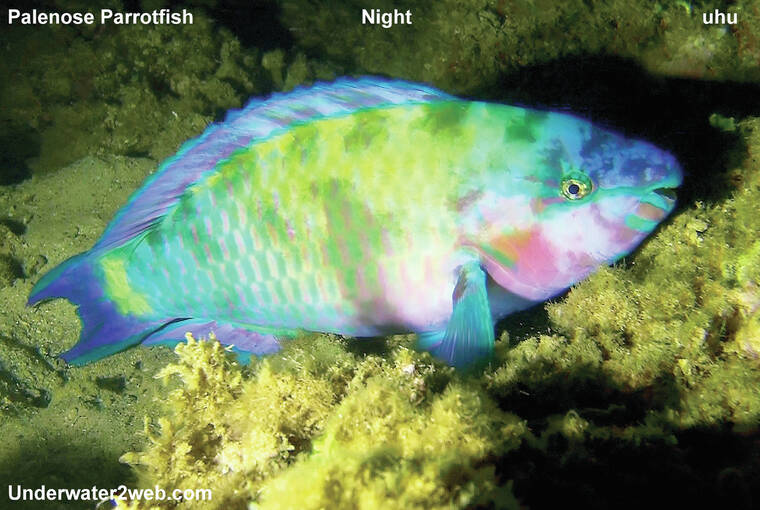Seeing a large male parrotfish out on the reef is very exciting because it is so colorful with bright blue, green, purple,red and yellow markings. These large male breeders are called “super males” and they usually can be found along with four or five females that have a dull reddish reef color. At one time in their life, the large adult males used to be females.
Uhu are in the wrasse family and when they hatch out they are all females. As they grow some of the females will convert into males and change from their drab reddish brown colors to the bright blue green adult males. This sex change is controlled by the females.
If a colony of females is healthy with lots of food, the females may only produce a single male for breeding. This male may fertilize five or six females, which produce millions of eggs. If the colony of females is under stress due to lack of food or environmental changes, the females may produce several males that will go out into the parrotfish colony and breed with different females. This can cause the entire colony to evolve so they can survive the changes in their reef habitat.
Fishermen often catch the colorful large blue green super males, but this is a bad idea because these large uhu are the breeders and one male may fertilize several million eggs. Parrotfish are super important for the health of the reef, as they feed on algae and dying sick corals, which makes room for new corals. Plus, the parrotfish poop out sand when they feed, which washes up on shore making our beautiful beaches.
When a super male is removed from the reef, one of the adult females will have to convert into a male. This process may take several years.
In the meantime, the other females may completely miss a year or two of breeding, which can damage the sustainability of these fish out on the reef. With many fish species it is a good idea to leave the large adult male breeders out on the reef, so they can produce a maximum number of babies for a sustainable future population.
On the small island of Molokini, off the coast of Maui, something very strange is happening with the parrotfish population. So many of the large super males over the past 20 years have been taken off of the reef that females now are converting into males when they are still very young so they can attempt to mate and produce at least a few offspring.
A super male uhu should be more than 24 inches long depending on the species. But out at Molokini there are blue green male parrotfish that are only 12 inches long.
This is not good for the future of the parrotfish on Molokini because these tiny males have a hard time breeding with the larger females and very few offspring are produced. One large 30-inch super male can fertilize more females than 10, tiny 12-inch long super males.
•••
Terry Lilley is a marine biologist living in Hanalei Kaua‘i and co-founder of Reef Guardians Hawai‘i, a nonprofit on a mission to provide education and resources to protect the coral reef. To donate to Reef Guardians Hawaii go to www.reefguardianshawaii.org.


